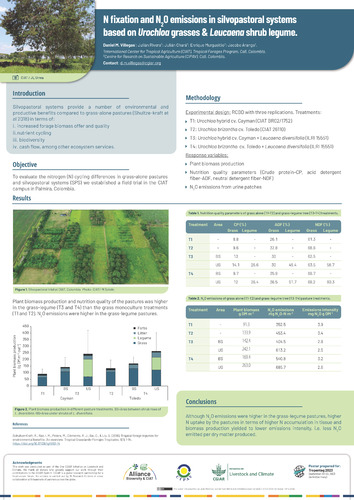Nitrogen fixation and nitrous oxide emissions in tropical silvopastoral systems based on Urochloa grasses and Leucaena shrub legume
Cattle production in tropical regions is largely dependent on monoculture pastures, which are characterised by low technology adoption and high land occupation. The introduction of legumes in tropical pastures has been proposed as a potential alternative to increase forage and animal productivity while maintaining soil quality without the use of synthetic inputs. However, the impact of increased nitrogen inputs via symbiotic fixation by legumes on soil nitrogen gaseous losses has received limited attention. To evaluate the potential of shrub legumes to improve nitrogen cycling in pastures of Valle del Cauca, Colombia, we conducted a one-year study from 2021 to 2022. Four pasture treatments, including Urochloa hybrid cv. Cayman and U. brizantha cv. Toledo alone and in association with the shrub legume Leucaena diversifolia, were evaluated. We measured plant biomass production, forage nitrogen uptake, nitrogen fixation of L. diversifolia, and nitrous oxide emissions from soil after the application of urine patches in the pastures. Pasture treatments associated with L. diversifolia produced up to 36% more forage biomass and showed up to 50% higher nitrogen concentration in leaf tissue than the Cayman and Toledo grasses growing alone. Furthermore, the proportion of nitrogen derived from the atmosphere in L. diversifolia was estimated to be around 50%. Although absolute nitrous oxide emissions after the application of urine patches were higher in pastures associated with L. diversifolia, the increase in forage production per unit area led to up to 18% lower intensity of emissions than in grass alone pastures. Our findings suggest that integrating Urochloa grasses with legumes such as L. diversifolia is a promising alternative to sustainably intensify animal production without increasing gaseous N losses.

